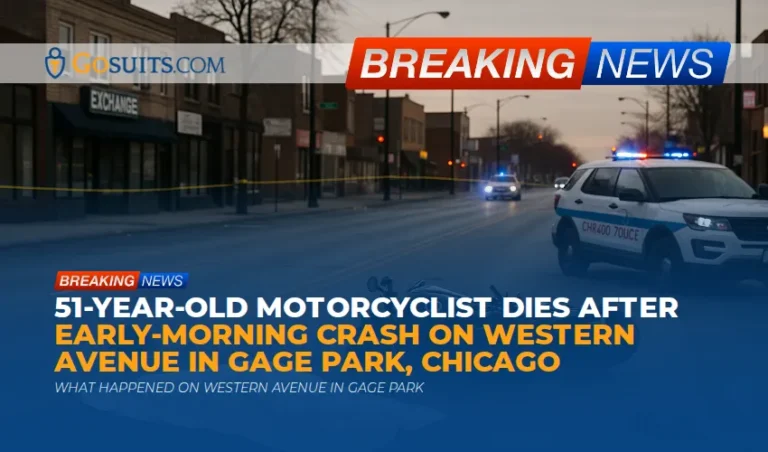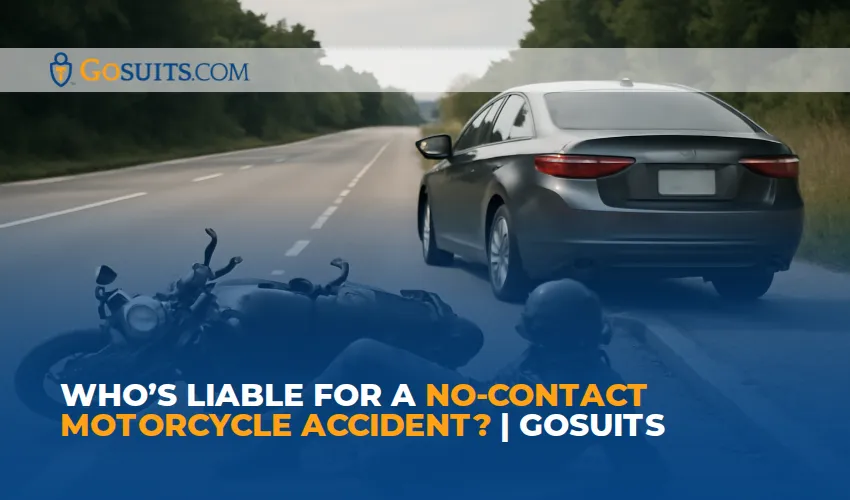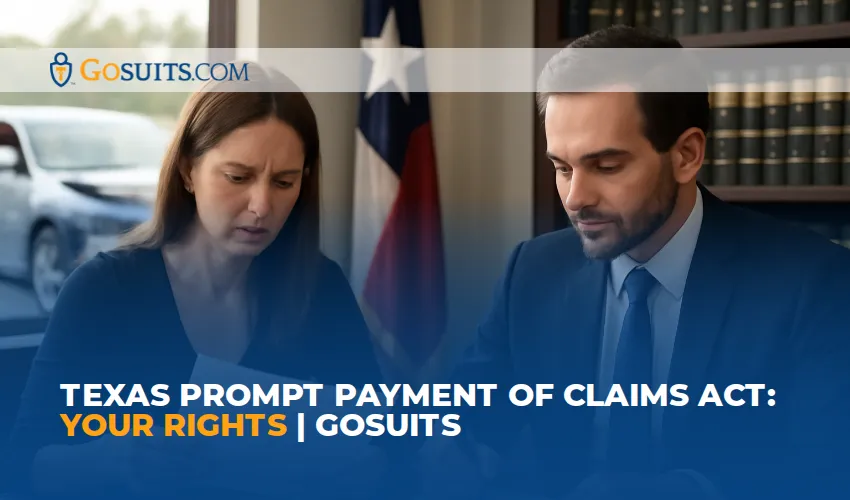- What happened on Western Avenue in Gage Park
- Local context: Gage Park, Western Avenue, and early-morning conditions
- How to obtain official information and documents in Chicago and Cook County
- Key investigation questions after a single-motorcycle crash
- Preserving evidence on the Southwest Side
- Liability overview in Illinois motorcycle crashes
- Insurance issues families commonly face
- Time limits and notice requirements in Illinois
- What the safety data says about motorcycle fatalities
- Emotional and practical support resources
- Commentary from Gosuits Chicago, Illinois Personal Injury Attorney
- Why taking action now matters
What happened on Western Avenue in Gage Park
According to the Chicago Police Department, a 51-year-old motorcyclist was involved in a fatal crash early Sunday morning on Chicago’s Southwest Side. The incident occurred on the 5500 block of Western Avenue, in the Gage Park area. Police reported the rider was traveling southbound when he lost control of the motorcycle. He was transported to St. Francis Hospital, where he died. No other injuries were reported, and the Chicago Police Department’s Major Accidents Unit is investigating. Authorities had not released the rider’s identity at the time of reporting, and the reason for the loss of control remained unclear.
Early reports sometimes include location details that need confirmation on the official crash report. If you’re a family member trying to understand exactly where this took place, the crash report number and CPD’s documentation will clarify the precise block, direction, and diagram of the scene.
Local context: Gage Park, Western Avenue, and early-morning conditions
Neighbors on the Southwest Side know Western Avenue as one of Chicago’s longest arterial roads. As it runs past Gage Park near 55th Street, traffic can vary dramatically between daytime and the early morning hours. Lighting, lane markings, road surface condition, and lingering weekend traffic patterns can all shape how safe a stretch of Western feels before sunrise. The 55th and Western corridor is lined with small businesses and corner shops that sometimes have exterior cameras. Several side streets in Gage Park also feed into Western with limited sight lines, which can create quick decision points for riders and drivers alike.
None of that explains this specific crash. But it provides context for the kinds of factors investigators typically examine on the Southwest Side: pavement condition, roadway debris, intersection controls, visibility of signage, and whether any other vehicle interaction preceded a loss of control, even if no other driver stopped at the scene. Families often find it helpful to understand how these details are reviewed, because they can point toward potential causes that aren’t immediately obvious from a short police summary.
How to obtain official information and documents in Chicago and Cook County
1) Chicago Police Department report and supplemental materials
For a crash within city limits, the primary report is generated by the Chicago Police Department. The Major Accidents Unit may also prepare diagrams, scene photos, and witness statements. Families can request:
- Illinois Traffic Crash Report for the incident
- Any available supplements such as diagrams or photographs
- Dispatch times or 911 audio, when releasable
Where to start:
- CPD Records Customer Service Section: You can request a copy of the crash report once it’s finalized. The CPD non-emergency line can guide you to the correct unit and current process. General CPD information line: 312-746-6000.
- 8th District (Chicago Lawn), which serves much of Gage Park, can help confirm the report number and transfer inquiries: 312-747-8730.
- Illinois Freedom of Information Act requests may be used for specific records that aren’t otherwise provided. See the Illinois FOIA statute at 5 ILCS 140.
Tip: Document the exact time, block, and direction of travel before calling. That helps personnel locate the report if you don’t yet have a report number.
2) Cook County Medical Examiner
If a death occurs following a sudden or unexpected incident, the Cook County Medical Examiner may investigate. Families can obtain information about the status of an examination and, when available, request reports through official channels.
- Office of the Cook County Medical Examiner: 312-666-0500
- Agency overview and requests: https://www.cookcountyil.gov/agency/medical-examiner
Cause and manner of death determinations can be important in civil claims. If toxicology is performed, final results may take additional time, and preliminary findings may be issued before a final report is complete.
3) Death certificates
Certified copies of the death certificate can be obtained through the Cook County Clerk. These documents are often required by life insurance carriers and to handle estate affairs.
- Cook County Clerk, Vital Records: https://www.cookcountyclerkil.gov/agency/vital-records
4) Traffic signal timing, street maintenance, and road condition records
If roadway design, signal timing, or maintenance played a role, records can sometimes be requested from the relevant public entities. In Chicago, traffic operations and street maintenance involve city departments and sometimes county or state agencies depending on the roadway designation. Requests may be made under Illinois FOIA. When government entities are involved as potential defendants, there are shorter deadlines and special rules, which are addressed below.
Key investigation questions after a single-motorcycle crash
Single-vehicle reports can be misleading. A rider may appear to have “lost control,” but the trigger could have been another driver cutting into the lane and fleeing, a sudden obstruction, a road defect, or a mechanical failure. Consider these avenues:
- Third-party vehicle interaction: Did a driver merge, open a door, swerve, or brake suddenly nearby? Even if there’s no contact, a negligent maneuver can force a rider into evasive action.
- Roadway condition: Potholes, loose aggregate, steel plates, standing water, and worn lane markings can contribute to loss of traction, especially in early morning hours. Documentation and measurements matter.
- Visibility and lighting: Bulbs out, obstructed signage, or reduced illumination at long corridors like Western Avenue can affect hazard recognition timelines.
- Speed and traffic flow: Actual travel speed relative to posted limits and context. Investigators review skid marks, yaw marks, and vehicle resting positions to estimate dynamics.
- Mechanical condition: Tire condition, brake components, and suspension can affect stability. Sudden punctures or failures may leave physical traces.
- Rider health and gear: Helmet and protective gear evidence, medical information, and incident biomechanics help reconstruct causation, though this is sensitive information.
It’s common for answers to emerge only after a full scene review, witness canvass, and analysis of available video. Western Avenue and the adjacent grid of side streets often have private security cameras. CTA buses are frequently equipped with interior and exterior cameras that may capture nearby traffic. Bus camera data isn’t guaranteed, but confirming whether a bus passed the area around the time of the crash can be important.
Preserving evidence on the Southwest Side
Time is the enemy of good evidence. Video systems overwrite themselves. Businesses change staff. Weather degrades skid marks and debris fields. Practical steps can make a real difference:
- Identify and preserve nearby video: Within 24 to 72 hours, visit or call businesses along the 5500 block of Western Avenue and nearby corners. Ask managers to preserve footage from the early morning window. Note camera angles that face the street.
- Canvas for witnesses: Early mornings can include shift workers, delivery drivers, or residents heading to work. Save names, phone numbers, and the exact time each person says they observed something.
- Photograph the roadway: Capture wide shots and close-ups of pavement defects, oil or fluid streaks, gravel patches, and any fresh utility work. Include a reference object for scale.
- Secure the motorcycle and gear: Helmets, jackets, and the bike itself can reveal impact directions, abrasion locations, and potential mechanical issues. Avoid altering the condition before a professional inspection.
- Request official records promptly: Use the report number to request CPD materials and, if warranted, FOIA requests for traffic, signal, or maintenance records related to that stretch of Western Avenue.
If there’s even a possibility that a public entity’s maintenance or design decisions are implicated, preserve all notes and copies of requests. Shorter deadlines apply, as explained below.
Liability overview in Illinois motorcycle crashes
In Illinois, responsibility for a crash can rest with multiple parties. Even if the initial report describes a single-vehicle loss of control, civil liability may extend to other drivers, product manufacturers, contractors, or public entities, depending on the facts. Here are frameworks Illinois families often encounter:
- Negligent drivers: A driver who cut off a motorcycle or forced evasive action can be liable even if there was no physical contact. Witness statements and video make these cases far stronger.
- Roadway maintenance and design: If a dangerous pothole, temporary plate, or missing warning signage is involved, claims may be considered against a city, county, or contractor. Claims involving public entities are subject to special immunity statutes and shorter deadlines.
- Defective parts or repairs: Tire failures, brake defects, or negligent workmanship can cause loss of control. This requires expert mechanical review and documentation of the components’ condition immediately after the crash.
When a fatality occurs, two related civil pathways are common in Illinois:
- Wrongful Death under the Illinois Wrongful Death Act (740 ILCS 180), which addresses losses suffered by surviving next of kin.
- Survival Action under the Illinois Survival Act (755 ILCS 5/27-6), which allows the estate to pursue claims the decedent could have brought if they had survived, such as pain and suffering before death.
Each pathway has different proof requirements and damages considerations. Families often pursue both together when supported by the evidence.

Insurance issues families commonly face
Insurance questions show up almost immediately, and decisions made in the first few days can shape the rest of the claim. Before speaking with any insurance company, it’s prudent to consult an attorney for a free, confidential review so you understand your rights. What you say to an insurer can be recorded and used to challenge your claim later, even if you’re simply trying to be helpful.
- Motorcycle policy coverages: In Illinois, bodily injury liability covers harm the rider is alleged to have caused to others. Medical payments coverage is optional and may help with immediate bills, depending on the policy. Uninsured and underinsured motorist coverages can apply if another driver contributed to the crash and fled or carried too little insurance.
- Other driver’s insurance: If evidence shows a driver’s actions contributed, their liability insurer may be on the hook. Expect requests for recorded statements. Decline until you understand the scope and implications.
- Government-related claims: If a roadway defect is implicated, notice and timing rules are strict. Claims must be framed carefully to avoid immunity defenses under the Tort Immunity Act.
- Health insurance and liens: Hospital and insurer liens can attach to any recovery. Understanding how these are negotiated and resolved helps families plan.
Documentation matters. Keep copies of all policies, any letters, and every phone call log. Don’t share broad medical authorizations without first understanding why they’re being requested.
Time limits and notice requirements in Illinois
Illinois has statutes that set deadlines for filing civil claims. Missing a deadline can end a case before it starts.
- General wrongful death and injury claims: Often two years from the date of the incident, though circumstances can alter this timeline. See the wrongful death statute framework at 740 ILCS 180.
- Claims involving local public entities: Civil actions against a local public entity or employee generally must be commenced within one year, with specific exceptions. See 745 ILCS 10/8-101.
- Public records timing: Requests under 5 ILCS 140 should be made promptly because video systems overwrite and construction records can become harder to locate over time.
Families often balance grief with pressing deadlines. A written timeline of the incident, medical care, and communications can help keep critical dates in view.
What the safety data says about motorcycle fatalities
National and state safety data provide context, even if they can’t explain any one tragedy.
- National trends: In recent years, the United States has experienced elevated motorcyclist fatalities compared with prior decades. NHTSA’s resources on motorcycle safety and recent Traffic Safety Facts publications describe rising fatality counts and the outsized risk riders face compared with occupants of enclosed vehicles. See NHTSA’s motorcycle safety overview at nhtsa.gov/road-safety/motorcycles.
- Risk factors: NHTSA notes factors commonly associated with motorcycle fatalities include lighting conditions, roadway environments, and alcohol involvement in a portion of cases, among others. These data points help frame investigations but are never a substitute for case-specific facts. See recent federal crash statistics via NHTSA’s CrashStats portal at crashstats.nhtsa.dot.gov.
- Illinois perspective: The Illinois Department of Transportation publishes annual crash facts that break down serious injuries and fatalities, including motorcycle crashes, by region and circumstance. Their statewide crash facts site is at idot.illinois.gov.
These sources help families and communities understand broader patterns, which can inform policy conversations about street design, lighting, speed management, and maintenance priorities along corridors like Western Avenue.
Emotional and practical support resources
The aftermath of a sudden loss is overwhelming. Between funeral planning, paperwork, and unanswered questions, it’s easy to feel pulled in every direction at once. Many neighbors lean on their faith communities around Gage Park, Brighton Park, and Chicago Lawn. Others turn to county and national resources. A few places to consider:
- SAMHSA 988 Suicide and Crisis Lifeline: If grief feels acute or you’re worried about someone’s safety, call or text 988 for 24/7 support. Learn more from SAMHSA at samhsa.gov/find-help/988.
- Cook County support services: The county maintains information hubs for behavioral health and survivor resources. Check the county website and ask your healthcare providers or social workers for direct referrals.
- Document organizer: Create a secure folder for the police report, medical examiner communications, death certificate, funeral receipts, insurance letters, and any employment or benefits documents. Simple organization can reduce day-to-day stress.
Commentary from Gosuits Chicago, Illinois Personal Injury Attorney
Our hearts go out to the family and friends of the rider who died along Western Avenue. We’re deeply sorry for your loss. This article is meant to provide general information and education about what typically follows a serious crash in our city. It isn’t a substitute for advice about any specific situation.
When we look at early reports that a motorcyclist “lost control,” we’re mindful that those words are a starting point, not a conclusion. On long, mixed-use corridors like Western, a momentary lane intrusion by another vehicle, fresh utility work, loose aggregate after a rain, or a new steel plate can set off a chain reaction. The Major Accidents Unit’s work, paired with timely video preservation from nearby businesses, often reveals details that initial summaries can’t. It’s important not to write off a single-vehicle crash as unexplainable before the evidence has been gathered.
Insurance carriers and large entities understand the power of the first narrative. They move quickly to obtain statements, shape the record, and identify defenses. In our experience, they may request broad medical authorizations, ask leading questions about speed or gear, or suggest that video isn’t available when it may still be recoverable from private systems. Corporations and insurers count on people not knowing what to ask for or how quickly footage is overwritten.
A confidential, no-cost consultation can help anyone involved understand their rights before they speak to an insurer. It’s a chance to discuss insurance coverages, potential third-party liability, preservation letters, and the short deadlines that apply if a public entity is involved. Even a brief conversation can prevent missteps that become hard to undo later.
Why taking action now matters
What to do next
- Secure the official record: Obtain the CPD crash report number and request the report and any available supplements.
- Preserve time-sensitive evidence: Ask nearby businesses on and around the 5500 block of Western Avenue to preserve exterior camera footage from the applicable early-morning window.
- Request medical examiner updates: Contact the Cook County Medical Examiner for status on cause and manner determinations and any pending toxicology timelines.
- Organize insurance information: Gather motorcycle policy documents, any health insurance information, and prior correspondence from insurers.
- Discuss your rights before any recorded calls: Consult with a seasoned attorney about what to say and what not to say to insurance adjusters.
Why it matters now
- Video disappears fast: Many systems overwrite within days. Early outreach can be the difference between having objective footage and relying solely on memory.
- Physical evidence degrades: Skid marks, debris patterns, and roadway hazards change with weather and traffic. Prompt documentation preserves the scene as it was.
- Deadlines run quietly: Illinois law imposes strict time limits, and cases involving public entities can have shorter windows. Acting early keeps all options on the table.
- Insurers build their file immediately: Adjusters begin evaluating liability and damages from day one. Understanding your rights before recorded statements helps prevent avoidable setbacks.

When and where it matters
- Within the first 72 hours: Focus on identifying cameras, securing CPD’s report number, and photographing the roadway near the crash location.
- Within the first two weeks: Submit requests to CPD and the Medical Examiner, canvas for witnesses, and evaluate whether any public-entity records should be requested under Illinois FOIA.
- Before any insurer statements: Make sure you understand the implications of recorded statements and broad medical authorizations; ask questions first, then decide how to proceed.
Trusted public sources for further reading
- Cook County Medical Examiner
- Cook County Clerk Vital Records
- Illinois Wrongful Death Act (740 ILCS 180)
- Illinois Survival Act (755 ILCS 5/27-6)
- Local Governmental and Governmental Employees Tort Immunity Act limitation (745 ILCS 10/8-101)
- Illinois Freedom of Information Act (5 ILCS 140)
- NHTSA Motorcycle Safety
- NHTSA CrashStats
- Illinois Department of Transportation Crash Facts
- SAMHSA 988 Suicide and Crisis Lifeline






